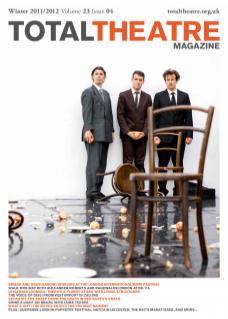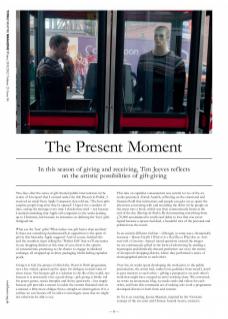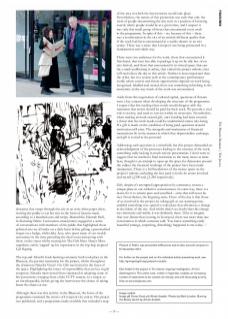Two days after the series of gift-themed public interventions in the centre of Liverpool that I curated under the title Present in Public, I received an email from Apple Computers that told me, ‘The best gifts surprise people long after they’re opened’. I kept it for a number of days, seeing the message every time I checked my mail – not because I needed reminding that Apple sell computers in the weeks leading up to Christmas, but because its insistence on defining the ‘best’ gifts intrigued me.
What are the ‘best’ gifts? What makes one gift better than another? Is there not something fundamentally in opposition to the spirit of gift in this hierarchy Apple suggests? And of course, behind this and the countless signs selling the ‘Perfect Gift’ that we’ll encounter in any shopping district at this time of year, there is the spectre of consumerism, promising us the chance to engage in idealised exchange, all wrapped up in shiny packaging whilst hiding capitalist profit.
Giving in to Gift, the project of which the Present in Public programme was a key strand, opened up the space for dialogue around some of these issues. Not because gift is a solution to the ills of the world, nor because it is necessarily even a good thing – gift-giving is fertile soil for power games, status interplay and showy generosity – but simply because gift provides a means to tackle the current financial crisis in a manner a little more oblique than a straight-on interrogation. It is a surface we can bounce off in order to investigate areas that we might not otherwise be able to see.
This take on capitalist consumerism was central to two of the six works presented. Alinah Azadeh, reflecting on the emotional and financial hold that institutions and people can gain on us, spent the afternoon conversing with and recording the debts of the people on the street into a book, which was then ceremoniously burnt at the end of the day (Burning the Books). By documenting everything from £70,000 accumulated in credit card debts to love that was never repaid because a spouse had died, a beautiful mix of the personal and political was the result.
In an entirely different fashion – although, in some ways, thematically resonant – Simon Farid’s I Want to be a Real Boy or What does an Actor want with a Conscience Anyway? raised questions around the images we are continuously gifted in the form of advertising by sending a mannequin and identically dressed performer out on to the streets of Liverpool’s shopping district, where they performed a series of choreographed actions to each other.
Over the six weeks spent developing the work prior to the public presentation, the artists had, under loose guidance from myself, acted as peer mentors to each other – gifting a perspective on each other’s work that might have escaped an artist working alone. We conversed, we wrote an anonymous blog, we made cards and videos for each other, and from this communal act of making solo work a programme developed diverse in both form and content.
In Try to eat everything, Jessica Mautner, inspired by the Victorian concept of the sin-eater and Chinese funeral sweets, created a character that swept through the city in an eerie white paper dress, inviting the public to eat her sins in the form of biscuits made according to a hundred-year-old recipe. Meanwhile, Hannah Hull, in Reclaiming Politics: Conversations around protest, engaged in a series of conversations with members of the public that highlighted those political acts we all make on a daily basis before gifting a personalised slogan on a badge, whilst Jake Ayre, who spent many of our weekly encounters in the time preceding the final event interacting with those on the street whilst wearing his The Gift Must Always Move superhero outfit, ‘rapped’ up his experiences in the hip-hop inspired Gift Rapping.
The rap and Alinah’s book-burning ceremony both took place in the Bluecoat, the partner institution for the project, whilst throughout the afternoon Natasha Vicars’ Free Gifts was hosted in the foyer of the space. Highlighting the issues of responsibility that are key in gift reception, Natasha interviewed those interested in adopting some of her possessions (ranging from a fake CCTV camera, to a teapot, to an encyclopaedia), before giving the interviewee the choice of taking home the object or not.
Although there was this activity in the Bluecoat, the focus of the programme remained the streets of Liverpool city centre. The project was publicised, and a programme made available that included a map of the area in which the interventions would take place. Nevertheless, the nature of this promotion was such that only the team of people documenting the day were in a position of knowing exactly where people would be at a given time, and I suspect it was only this small group of three that encountered every work in the programme. In spite of this – no, because of this – there was a reverberation in the city of an entirely different quality than if the work had been concentrated in a studio theatre or an arts centre. There was a sense that Liverpool was being permeated in a fundamental and subtle way.
There were two audiences for the work, those that encountered it first-hand, that were less able to package it up in the tidy box of an arts festival, and those that encountered it in virtual space: that saw the e-mails publicising it online, that visited the project website, that will read about the day in this article. Neither is more important than the other, but in a system such as the contemporary performance world, where careers and future opportunities depend on work being recognised, labelled and owned, there was something refreshing to the anonymity in the way much of the work was encountered.
Aside from this negotiation of cultural capital, questions of finance were a key concern when developing the structure of the programme. I suspect that few reading these words would disagree with the sentiment that artists should be paid for their work. We provide a vital role to society, and need to survive within its structures. Nevertheless, when making artwork around gift, once funding had been secured, a threat that the work made could be undermined comes into being. If a gift is made on the condition of being paid, questions around motivation will arise. The strengths and weaknesses of financial transactions lie in the manner in which they depersonalise exchange, and gift is rooted in the personal.
Addressing such questions is a minefield, but this project demanded an acknowledgment of the processes leading to the creation of the work, something sadly lacking in much artistic presentation. I don’t want to suggest that we reached a final resolution to the many issues at stake here, though in an attempt to open up the space for discussion around the subject the financial workings of the project have been made transparent. There is a full breakdown of the money spent on the project’s website, including the fees paid to both the artists involved and myself (£500 and £1,285 respectively).
Gift, despite it’s attempted appropriation by commerce, retains a unique place in our collective consciousness. In some way, there is a desire for it to remain pure and unsullied – aims that will never be met. Nevertheless, the lingering sense I have of the day is that those of us involved in the project, by taking gift as our starting point, enabled something very special to take place that afternoon; a change in the fabric of the city. And whilst there’s no doubt that this change was miniscule and subtle, it was definitely there. I like to imagine that over dinner that evening in Liverpool, there was more than one conversation in which someone said: ‘You know something really beautiful (strange, surprising, disturbing) happened to me today…’
Present in Public was presented at Bluecoat and at sites around Liverpool on 12 November 2011.
For further on the project and on the individual artists presenting work, see http://givingintogift.org/present-in-public
Also linked to the project is Tim Jeeves’ ongoing investigation, Artist’s Statefragment. This online work, written in hypertext, enables an increasing number of statements to be viewed non-linearly and with fluctuating priority. View at www.timjeeves.com


